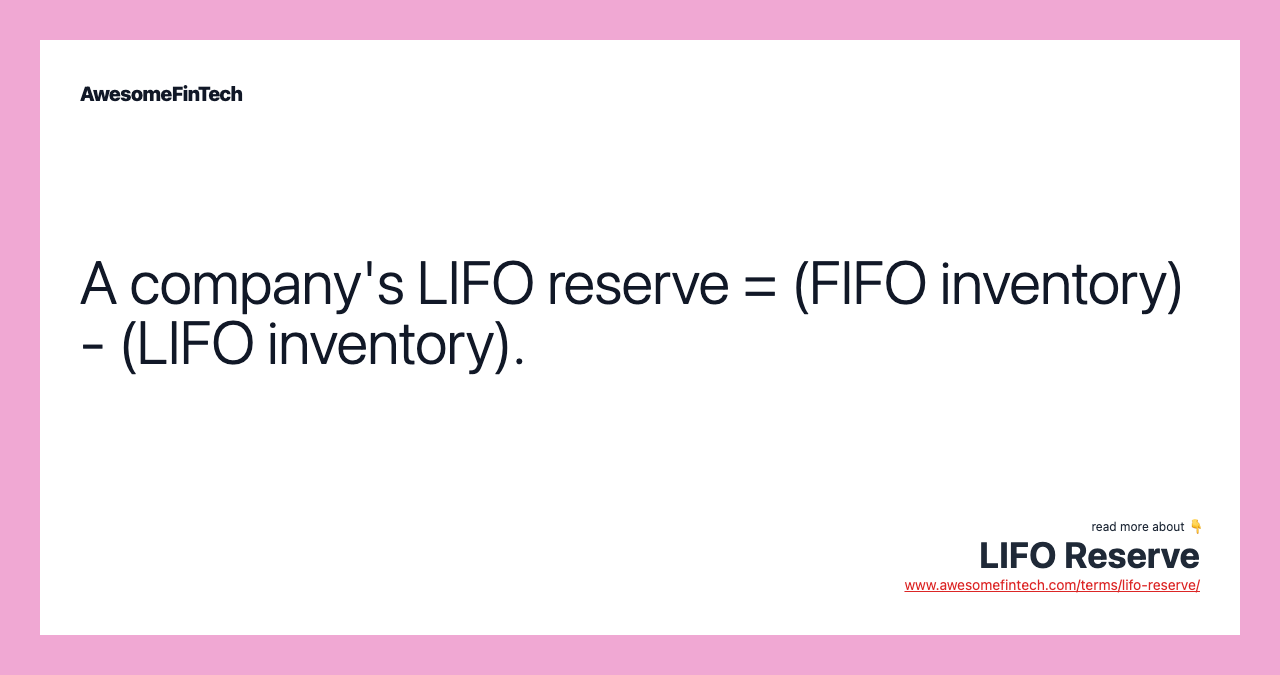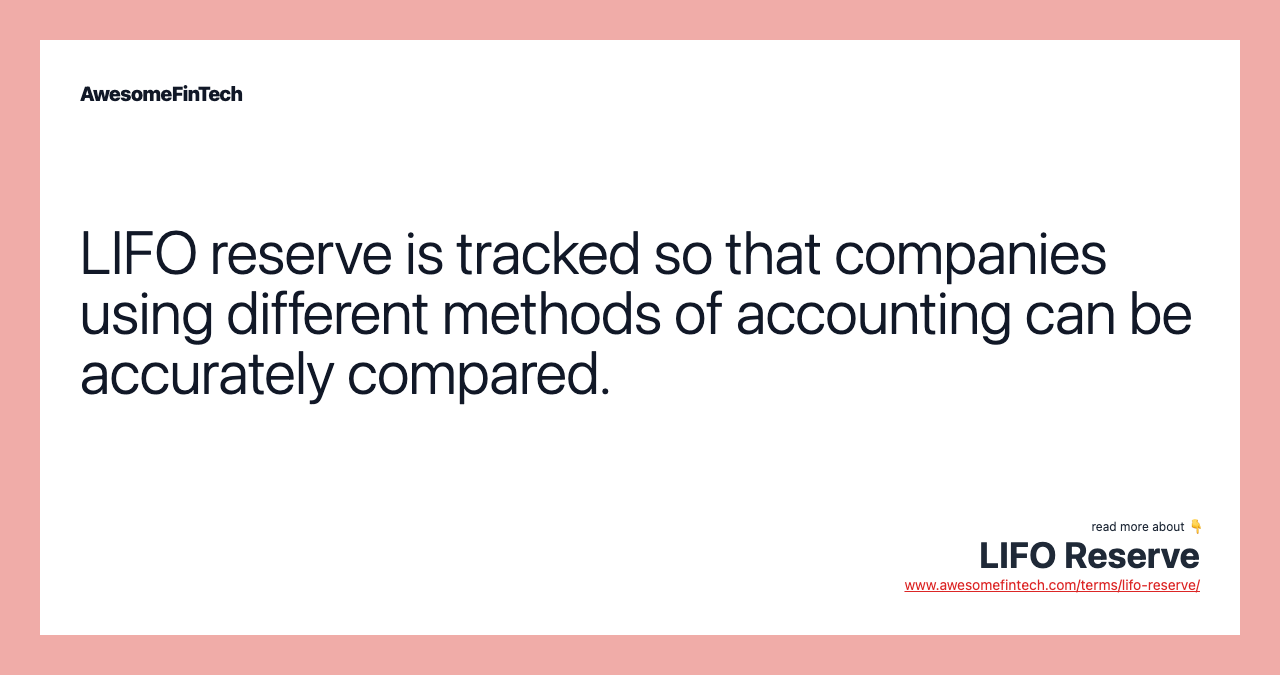LIFO Reserve
LIFO reserve is an accounting term that measures the difference between the first in, first out (FIFO) and last in, first out (LIFO) cost of inventory for bookkeeping purposes. Often earnings need to be adjusted for changes in the LIFO reserve, as in adjusted EBITDA and some types of adjusted earnings per share (EPS). When preparing company financials for the LIFO method, the difference in costs in inventory between LIFO and FIFO is the LIFO reserve. The LIFO reserve is an account used to bridge the gap between FIFO and LIFO costs when a company uses the FIFO method to track its inventory but reports under the LIFO method in the preparation of its financial statements. A company's LIFO reserve = (FIFO inventory) - (LIFO inventory). LIFO reserve is tracked so that companies using different methods of accounting can be accurately compared. For example, when using the LIFO method for inventory accounting in periods of rising prices, the cost of reported inventory is higher than the FIFO method, which, therefore, increases a company's cost of goods sold (COGS), decreasing its pre-tax earnings.

What Is LIFO Reserve?
LIFO reserve is an accounting term that measures the difference between the first in, first out (FIFO) and last in, first out (LIFO) cost of inventory for bookkeeping purposes. The LIFO reserve is an account used to bridge the gap between FIFO and LIFO costs when a company uses the FIFO method to track its inventory but reports under the LIFO method in the preparation of its financial statements.







Understanding LIFO Reserve
The FIFO method of evaluating inventory is where the goods or services produced first are the goods or services sold first, or disposed of first. The LIFO method of evaluating inventory is when the goods or services produced last are the ones to be sold or disposed of first.
The LIFO reserve comes about because most businesses use the FIFO, or standard cost method, for internal use and the LIFO method for external reporting, as is the case with tax preparation. This is advantageous in periods of rising prices because it reduces a company's tax burden when it reports using the LIFO method.
The LIFO reserve is known as a contra inventory account. A contra account's balance is the opposite of the account it is associated with.
LIFO vs. FIFO
For example, when using the LIFO method for inventory accounting in periods of rising prices, the cost of reported inventory is higher than the FIFO method, which, therefore, increases a company's cost of goods sold (COGS), decreasing its pre-tax earnings. When pre-tax earnings are lower, there is a lower amount to pay taxes on, thus, fewer taxes paid overall.
Then, for internal purposes, such as in the case of investor reporting, the same company can use the FIFO method of inventory accounting, which reports lower costs and higher margins, which is attractive to investors. In periods of rising prices, constant increases in costs can create a credit balance in the LIFO reserve, which results in reduced inventory costs when reported on the balance sheet.
Almost all analysts look at a publicly-traded company's LIFO reserve. Often earnings need to be adjusted for changes in the LIFO reserve, as in adjusted EBITDA and some types of adjusted earnings per share (EPS).
Calculating LIFO Reserve
When preparing company financials for the LIFO method, the difference in costs in inventory between LIFO and FIFO is the LIFO reserve. Therefore, a company's LIFO reserve = (FIFO inventory) - (LIFO inventory). LIFO reserve is usually tracked so that companies using different methods of accounting can be accurately compared.
In order to ensure accuracy, a LIFO reserve is calculated at the time the LIFO method was adopted. The year-to-year changes in the balance within the LIFO reserve can also give a rough representation of that particular year's inflation, assuming the type of inventory has not changed.
Accounting professionals have discouraged the use of the word "reserve," encouraging accountants to use other terms like "revaluation to LIFO," "excess of FIFO over LIFO cost," or "LIFO allowance."
Benefits of LIFO Reserve
As stated, one of the benefits of the LIFO reserve is to allow investors and analysts to compare companies that use different accounting methods, equally. The most important benefit is that it allows a comparison between LIFO and FIFO and the ability to understand any differences, including how taxes might be impacted.
This allows companies to better adjust their financial statements and budget in regards to sales, costs, taxes, and profits.
Related terms:
Adjusted EBITDA
Adjusted EBITDA (earnings before interest, taxes, depreciation, and amortization) is a measure computed for a company that takes its earnings and adds back interest expenses, taxes, and depreciation charges, plus other adjustments to the metric. read more
Cost of Goods Sold – COGS
Cost of goods sold (COGS) is defined as the direct costs attributable to the production of the goods sold in a company. read more
Contra Account
A contra account is an account used in a general ledger to reduce the value of a related account. A contra account's natural balance is the opposite of the associated account. read more
Ending Inventory
Ending inventory is a common financial metric measuring the final value of goods still available for sale at the end of an accounting period. read more
Earnings Per Share (EPS)
Earnings per share (EPS) is the portion of a company's profit allocated to each outstanding share of common stock. Earnings per share serve as an indicator of a company's profitability. read more
First In, First Out (FIFO)
First-in, first-out (FIFO) is a valuation method in which the assets produced or acquired first are sold, used, or disposed of first. read more
Inflation
Inflation is a decrease in the purchasing power of money, reflected in a general increase in the prices of goods and services in an economy. read more
Inventory Management
Inventory management is the process of ordering, storing and using a company's inventory: raw materials, components, and finished products. read more
Inventory :
Inventory is the term for merchandise or raw materials that a company has on hand. read more
Last In, First Out (LIFO)
Last in, first out (LIFO) is a method used to account for inventory that records the most recently produced items as sold first. read more